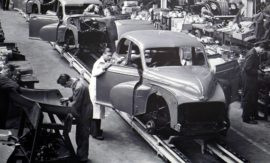Intended learning outcomes: Disclose values of characteristic features for low-variety manufacturing.
Continuation from previous subsection (7.1.1)
Figure 7.1.1.3 shows the characteristics of low-variety manufacturing. Customer tolerance time allows usually to produce some of the highest structure levels according to customer order. Ideally, variants arise only at these structure levels, e.g., assembly. The characteristic of low-variety manufacturing is somewhere between the two characteristics of standard product manufacturing (Figures 5.1.2.1, 5.1.2.2, and 5.1.3.1) and high-variety manufacturing.
Fig. 7.1.1.3 Values of the characteristic features for low-variety manufacturing.
- Products downstream from the (customer) order penetration point (OPP) are preferably manufactured according to the batch size of the customer order, sometimes with small batch production to stock. Here, there is production with infrequent order repetition, as there are only a limited number of variants.
- Upstream from or at the (customer) order penetration point (OPP), products are manufactured and stored prior to customer demand. Here, order processing has the character of standard products manufacturing. If variants are produced down-stream from the order penetration point, production upstream from the order penetration point is production with frequent order repetition. Otherwise, it is production with infrequent order repetition.
- Reason for order release and type of long-term orders: For goods downstream from the order penetration point, we find the character of high-variety manu-facturing. Upstream from or at the order penetration point, order processing has the character of standard products manufacturing. Forecast and blanket orders refer here to product families.
Quiz: Characteristics of a Product Variety Concept.
Course section 7.1: Subsections and their intended learning outcomes

7.1 Logistics Characteristics of a Product Variety Concept
Intended learning outcomes: Differentiate between high-variety and low-variety manufacturing. Describe different variant-oriented techniques, and the final assembly schedule.

7.1.1 High-Variety Manufacturing
Intended learning outcomes: Identify values of characteristic features for high-variety manufacturing. Explain long- and medium-term planning for manufacturing according to customer specification or of product families with many variants.

7.1.1b Low-Variety Manufacturing
Intended learning outcomes: Disclose values of characteristic features for low-variety manufacturing.

7.1.2 Different Variant-Oriented Techniques
Intended learning outcomes: Differentiate between adaptive and generative variant-oriented techniques. Disclose typical sets of characteristics and production types that arise frequently with the four product variety concepts.

7.1.2b The Final Assembly Schedule (FAS)
Intended learning outcomes: Present the concept of the final assembly schedule (FAS). Describe how the MPS concerns the highest structure level still having a small number of different items. Identify FAS/MPS/OPP patterns in dependency on the product variety concept and their relation to the patterns of the T analysis.
